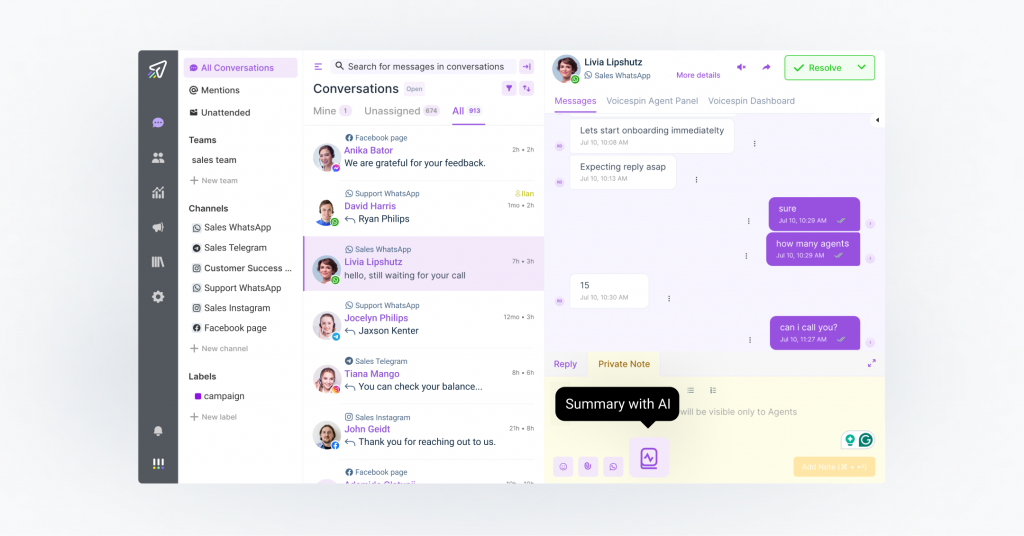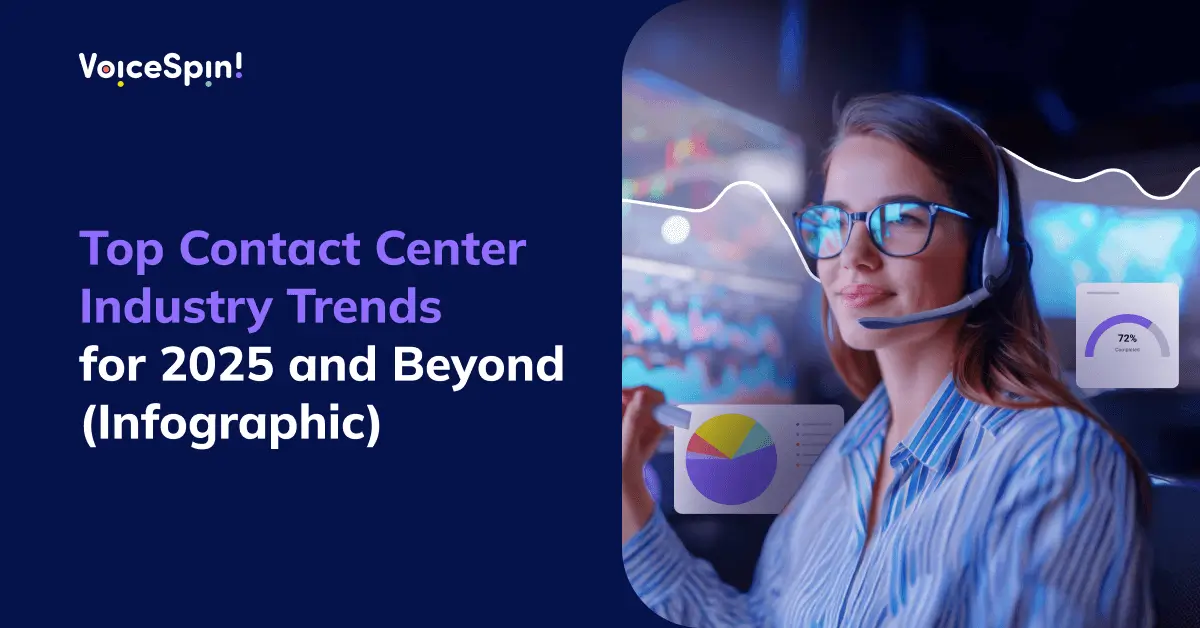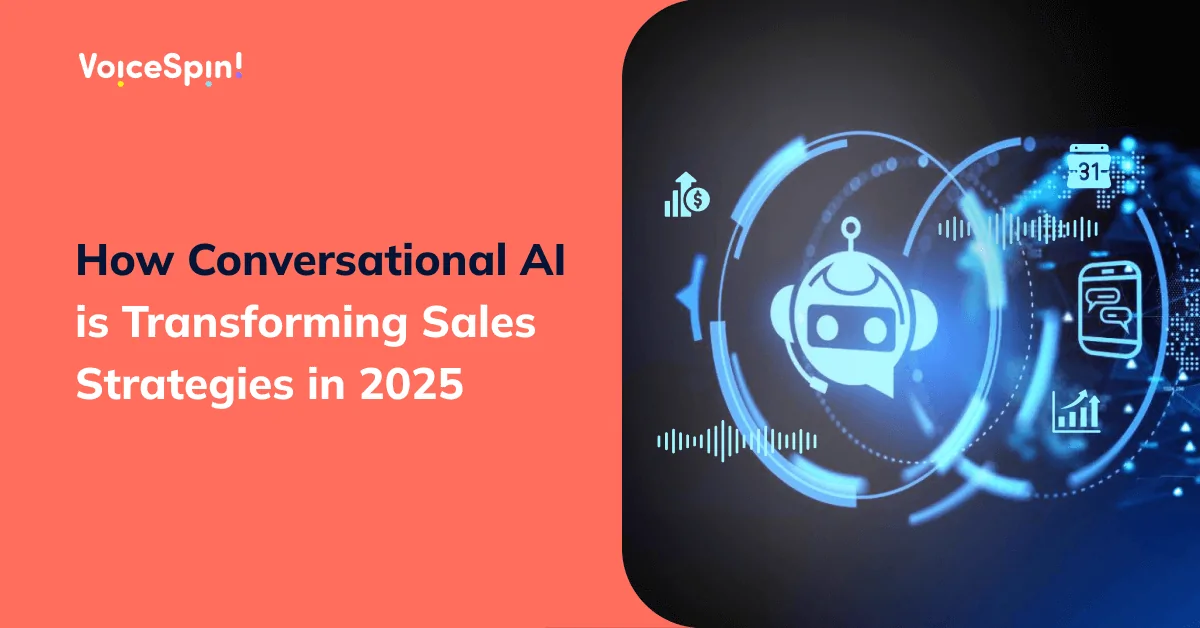Let’s face it – the contact center industry is constantly evolving, driven by technological innovations and ever-changing customer expectations. And if you want to stay competitive, following the latest cloud contact center trends isn’t just a good practice but a necessity for your business. Fortunately, you don’t have to dig through dozens of research studies to be in the loop of what’s going on and where the industry is headed – we’ve already done that part for you!
So, what are some of the most significant trends in the contact center industry to keep an eye on for 2025 and beyond? In this blog, we’ll uncover the top 10 research-backed trends shaping the future of the contact center industry to help you stay ahead of the curve.

1. The cloud-based contact center software market continues to grow
In response to pandemic, many contact centers (along with businesses across many other industries) migrated to the cloud. According to research from Calabrio, nearly three-quarters of contact centers already use a partially or fully integrated cloud solution, suggesting that it’s becoming the industry norm.
Cloud-based technology truly offers a bunch of benefits for contact centers in terms of flexibility, almost instant scalability, access to advanced features, and cost-efficiency. With a cloud-based contact center software solution, you can easily scale your operations up or down based on demand. Your agents can access the system from everywhere as long as they have a reliable internet connection, enabling remote work and access to a wider global talent pool.
On top of that, cloud-based contact centers are much quicker to set up compared to implementing on-premises solutions and reduce the burden of infrastructure and maintenance costs. No wonder the market for cloud-based contact center solutions keeps growing at a rapid pace. In fact, based on Mordor Intelligence™, the cloud-based contact center market (estimated at USD 27.22 billion in 2024) is expected to reach USD 87.10 billion by 2029.
2. Contact centers are becoming increasingly digital and omnichannel
Omnichannel isn’t just a buzzword anymore, but one of the top contact center market trends we’re witnessing now. As call center technology continues to advance, and more consumers are expecting to interact with brands across digital communication channels, many call centers have already transitioned to omnichannel communication hubs. This is mainly driven by the rise of digital channels and increasing consumer expectations for seamless omnichannel experiences. Let’s take a look at some of the stats behind this trend:
- Over half of consumers engage with 3 to 5 channels during each journey they take toward making a purchase or resolving a request. (McKinsey)
- B2B buyers engage with companies across ten channels, and B2C consumers typically use eight. (Salesforce)
- 71% of customers prefer using different communication channels depending on context. (Salesforce)
- When interacting with brands, 78% of consumers use multiple channels to start and complete a transaction. (Salesforce)
If you haven’t given your customers an opportunity to engage with your brand across their preferred channels, you’re probably not keeping up with your customers’ expectations.
3. Contact centers still struggle to deliver seamless omnichannel experiences
Connected, consistent experiences have become critical to maintaining customer satisfaction. However, even though contact centers are increasingly becoming more digital and omnichannel by supporting their customers on multiple communication channels, many are still unable to deliver a seamless omnichannel experience across all touchpoints.
According to a report from Deloitte Digital, 40% of organizations that serve in multiple channels say their channels are isolated, with little or no visibility to prior interactions across channels. And only 7% of contact centers that offer multiple service channels are able to transition customers between channels seamlessly by providing customer data, history, and context to the next agent or system.
At the same time, based on Salesforce research, 79% of customers expect consistent interactions across departments, 70% expect all company representatives to have the same information about them, but 56% often have to repeat or reexplain information to different representatives.
If you’re struggling to deliver consistent experiences across multiple support channels, consider implementing an omnichannel contact center solution like VoiceSpin’s AI Messaging that enables your contact center agents to handle customer interactions across all touchpoints from a single omnichannel inbox with the full context of previous interactions.
Recommended reading: How to Implement Omnichannel Customer Service in Your Business
4. Customer self-service solutions are being widely adopted in contact centers
The demand for self-service is on the rise – and numerous research studies have proven that. For example, based on a report from Higher Logic, 79% say they expect organizations to provide self-service support tools to help customers find answers without having to contact support. Moreover, 84% of consumers try to solve support issues on their own before they reach out to customer support. And 77% even say they view organizations more positively if they offer self-service options.
Salesforce research also shows an undeniable shift towards self-service in customer interactions, with 61% of consumers claiming they would rather use self-service tools for simple issues. This is particularly true for digital natives – i.e., millennials and Gen Z.
As consumers have become more self-reliant, more contact centers are going to invest in implementing self-service tools. A report from Deloitte Digital revealed that 9 in 10 contact center leaders are planning to invest in additional self-service capabilities in the next two years, with a goal of driving customers to conversational IVRs, interactive FAQs, virtual agents, and/or chatbots.
Not only will it enable faster support and better experiences for customers; implementing self-service support tools also allows contact centers to cut down on their support costs by reducing telephony expenses and overall number of support requests that need to be handled by human reps.
5. Conversational AI chatbots and voice bots gain greater importance in customer service interactions
Chatbots have been around for decades, but only in recent years (thanks to advancements in AI, ML, and deep learning) have they become much more sophisticated (read: smart) and efficient in handling customer service interactions. Not surprisingly, more consumers are now willing to use conversational AI chatbots when seeking answers to straightforward questions or trying to resolve basic issues.
Based on Outgrow stats, 96% of customers heard about chatbots and know what they are, while 74% would choose a chatbot over a human agent to look for answers to simple questions. And what’s more, over 60% of consumers would actually rather talk to a chatbot than a human agent if the alternative were to wait 15 minutes for an answer.
AI chatbots deliver quick answers 24/7 and empower consumers to get information and resolve issues on their own, whenever it’s convenient for them. To keep up with customer expectations, more contact centers are planning to implement chatbots into their customer service processes. No wonder Gartner predicted that by 2027, chatbots will become the primary customer service channel for roughly a quarter of organizations.
In fact, many contact centers are already using AI chatbots successfully. According to a report from Botco.ai, 76% of contact centers leverage chatbot technologies – and among the 19% who don’t use chatbots, 31% said their contact centers plan to implement chatbots in the near future. Intercom’s report also revealed that 45% of CX teams are already using AI chatbots – and the majority state that up to 30% of their support requests are being successfully resolved by AI chatbots.
Recommended reading: Enterprise Chatbots: Features, Benefits, and Common Use Cases
Along with AI chatbots, AI voice bots (otherwise known as AI voice agents) are also becoming incredibly popular as more businesses are looking for ways to automate their call center operations. This is especially true for businesses where phone remains the primary customer support channel. According to the Voicebots Market Report by IndustryARC, the voicebots market size is estimated to reach $98.2 billion by 2027, growing at a CAGR of 18.6% during the forecast period 2022-2027.
Similarly to AI chatbots, AI voice bots can answer repetitive questions and provide accurate information about your products or services. And what’s more, when integrated with CRM, e-commerce platforms, calendar software, and other back-end systems, AI voice bots can do so much more than just answering questions and delivering information. Some of the most advanced solutions can book appointments, make reservations, update account information, modify subscriptions, initiate product returns, and process refunds – all without involving your reps.
Recommended reading: Customer Service AI Voice Bots: The Ultimate Guide
6. IVR still matters in contact centers but becomes more AI-driven
Despite the rise of digital communication channels, the majority of contact center operations are still happening over the phone. Based on a Salesforce report, 88% of consumers prefer to interact with brands through phone calls. And when people pick up the phone to reach out to customer service agents, they expect to be connected to the right person. This is where Interactive Voice Response (IVR) remains critical in call centers and contact centers.
Not only do IVR systems route incoming calls to the best-suited call center agents, helping you reduce call transfers, improve FCR rates, reduce the average handle times, and increase CSAT scores. IVR menus are also efficient for answering FAQs and addressing basic customer service issues without involving your reps.
IVR is clearly here to stay, with the global IVR market size expecting to reach USD 9.26 Billion by 2031 (from USD 5.56 Billion in 2024), according to Verified Market Research.
On top of that, IVR systems are gradually becoming more advanced as they blend with advanced analytics, AI, Natural Language Processing (NLP), speech recognition, voice biometrics, and other pioneering tech advancements. According to McKinsey, next-gen IVR systems can reduce the number of live-agent calls by over 10% and deliver a fivefold improvement in customer satisfaction scores.
7. Generative AI will play a crucial role in improving CX and agent productivity
Generative AI is already transforming customer service and the contact center industry in general. According to Gartner, by 2025, 80% of customer service and support organizations will be applying Generative AI technology in some form to improve agent productivity and customer experience. So, how exactly is Generative AI used in contact centers and how does it improve agent efficiency and CX? Let’s take a closer look at some of the key use cases for Generative AI in call centers and contact centers:
AI Agent Assist solutions:
AI agent assist solutions can help agents during customer interactions across voice and digital channels by analyzing conversations, retrieving relevant data from your knowledge base and CRM system, and suggesting responses your reps can use to streamline conversations. With real-time guidance from AI agent assist tools, your reps can respond faster and more effectively, reducing AHT and improving CX.
More specifically, based on an NBER study, access to AI assistance can increase the productivity of customer support agents by 14%, as measured by the number of issues they are able to resolve per hour. Increased performance is particularly noted among less skilled and less experienced agents.
AI Call Summarization:
Call summarization automatically extracts critical information and creates an accurate summary of each transcribed call, giving you insights into conversations between your customers and call center reps. A summary may include key conversation points, customer sentiment, action items, resolutions offered by the agents, or any other important information.
For example, VoiceSpin’s AI call summary feature allows you to set your own criteria for call summarization based on what you’d like your call summaries to include. With call summarization, you can reduce after-call work, saving your reps a great deal of time and effort and enabling them to focus on higher-value tasks. Besides, it can help you streamline your call center quality assurance and performance management processes.
Recommended reading: Generative AI in Contact Centers: the Ultimate Guide for 2025
8. Contact centers will leverage speech analytics for better personalization
In the big data age, consumers demand more personalized experiences when interacting with brands. According to McKinsey, 71% of consumers expect companies to deliver personalized interactions, and 76% get frustrated when this doesn’t happen. Furthermore, here are some other findings on the importance of personalization from the McKinsey’s survey:
- 76% of consumers are more likely to consider purchasing from brands that personalize
- 78% of consumers are more likely to refer friends and family to companies that personalize
- 78% of consumers are more likely to make repeat purchases from companies that personalize
It literally means that personalization isn’t just essential in influencing consumers’ buying decisions. It’s also one of the key driving factors of customer loyalty. And while there are many tools businesses can leverage for better personalization across the customer journey, contact centers will increasingly implement speech analytics and sentiment analysis solutions to deliver more personalized customer experience and maintain customer satisfaction.
As more contact centers will be looking to implement speech analytics solutions, the market for speech analytics is expected to witness significant growth. According to MarketsandMarkets™, the speech analytics market is projected to grow from USD 3.3 billion in 2024 to USD 7.3 billion by 2029.
9. Contact centers are transforming from cost centers to key revenue drivers
Up until recently, contact centers and call centers were typically considered cost centers. But luckily, not anymore. Over the past decade, the majority of businesses dramatically changed how they think about the role of contact centers and the customer service experience they deliver.
Implementation of AI, Robotic Process Automation (RPA), speech analytics, generative AI, chatbots, and other call center automation solutions in contact centers has played a significant role in transforming them into profit centers. Based on Calabrio’s research, 88% of contact center managers around the world said their customer service has a direct impact on revenue and profitability.
The reason for this shift is pretty obvious, as most of today’s businesses are competing on the basis of customer experience. And there are plenty of stats on how consumers are making buying and loyalty decisions based on customer experience, how quickly they defect after poor service experiences, and how much brands are losing due to poor CX. Here are just a few to mention:
- 97% of consumers report that their interactions with contact centers influence their loyalty to a brand, with two-thirds stating these interactions are highly or extremely influential. (Calabrio)
- 84% of customers say the experience a company provides is as important as its products and services, and 66% are willing to pay more for a great experience. (Salesforce)
- 3 in 4 consumers (75%) will spend more with businesses that provide a good customer experience. (Zendesk)
- 53% of consumers have cut spending after a single bad experience with a company, and businesses globally stand to lose $4.7 trillion in consumer spending due to poor customer experiences. (Qualtrics)
Contact centers are now empowered to use AI, data-driven insights, and other next-gen technologies to deliver highly personalized experiences and enhance revenue through strategies like upselling and cross-selling, turning them into real revenue drivers for businesses.
10. Remote work will continue to dominate the workplace in contact centers
The pandemic forced many businesses to shift rapidly to work-from-home models – and contact centers are no exception. While it seemed challenging at first, this shift soon began to reveal undeniable benefits for both contact centers and employees. Instead of hiring within a close geographic radius, contact centers could suddenly reach a wider talent pool and hire anyone, anywhere. And what’s more, remote work brought greater cost-savings to contact centers in terms of reduced operational costs.
From the agents’ perspective, shifting to a remote, work-from-home model enabled greater flexibility and better work-life balance. And that, in turn, resulted in increased job satisfaction and allowed contact centers to improve retention and reduce employee turnover, which has traditionally been high in the contact center industry.
Despite the recent return-to-office hype, with companies like Amazon, Starbucks, and Disney demanding their employees to return to the office entirely or at least several days a week, remote and hybrid working models will continue to dominate the workplace in contact centers.
Based on a report from Deloitte Digital, 69% of contact centers still have a work-from-home program in place, with 73% expecting to have a work-from-home program in place within two years to address recruitment and retention needs.
Stay on Top of Contact Center Technology Trends with VoiceSpin Contact Center Software

Based on the contact center future trends we’ve discussed above, the industry is clearly transforming and will continue to evolve alongside tech advancements and shifting customer expectations. To be ready for what comes ahead, you need a reliable, omnichannel-ready contact center software platform. That’s where VoiceSpin comes in. Whether you’re looking to upgrade your current contact center tech stack or implement your first contact center software solution, VoiceSpin might be just the right choice. Here’s why:
- Cloud-based platform: With the infrastructure hosted on the public cloud, VoiceSpin is easy to set up, manage, and scale to meet the growing needs of your business almost instantly without disrupting your operations.
- Numbers in 160+ countries: With an extensive network of telco partners all across the globe, VoiceSpin enables you to get local DID numbers in 160+ countries and enjoy the best quality/ price ratio on the market.
- Omnichannel readiness: Integrate multiple channels (including email, live chat, social media, and WhatsApp) into one platform, manage customer interactions across all touchpoints from a single omnichannel inbox, and deliver a seamless CX.
- AI chatbots and AI voice bots: With AI chatbots and AI voice bots, you can deliver customer support 24/7, help your customers get immediate answers to their questions without ever being put on hold, and instantly qualify inbound leads.
- Real-time and historical reporting: Keep tabs on how your contact center is performing with real-time and historical reporting. Build custom reports and track metrics and KPIs that matter most to your business.
- AI Speech analytics: Gain granular visibility into your contact center operations with an integrated AI speech analytics, ensure compliance through keyword spotting, and better assess your team’s performance with AI conversation summaries.
- Third-party integrations: With out-of-the-box integrations with 50+ most popular CRM systems, helpdesk software, and productivity apps and custom integration options, you can seamlessly integrate VoiceSpin with the rest of your tech stack.
- 24/7 customer support: Get access to professional customer support that is available round-the-clock through multiple communication channels and always ready to assist whenever you need help, regardless of your subscription plan.
Book a demo call now to learn more about how VoiceSpin’s AI contact center solutions can help you improve customer experience, your team’s productivity, and operational efficiency.





 +18889082995
+18889082995
 +442036084160
+442036084160
 +97237237006
+97237237006